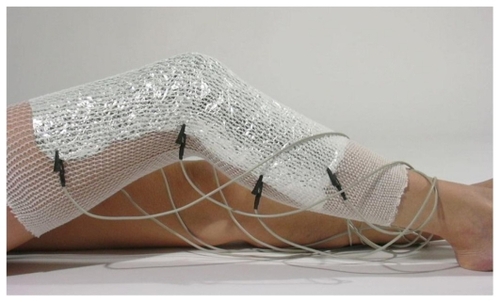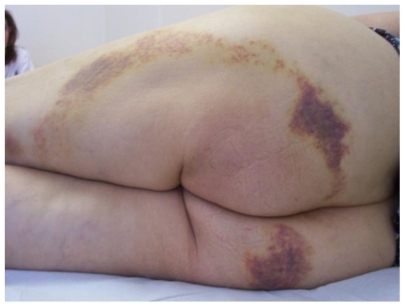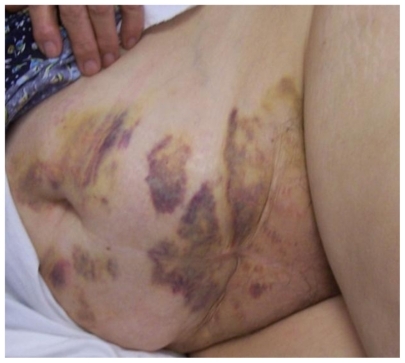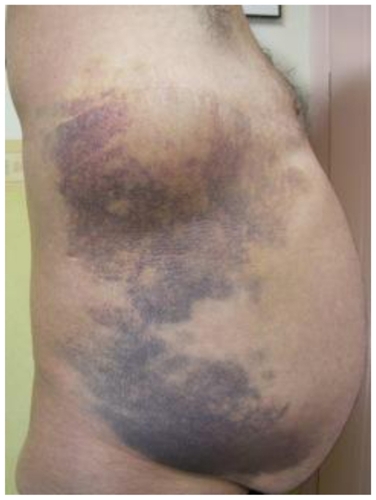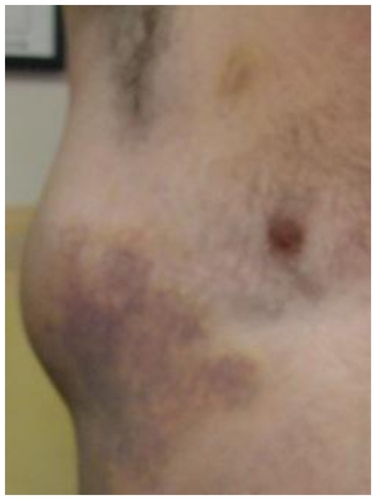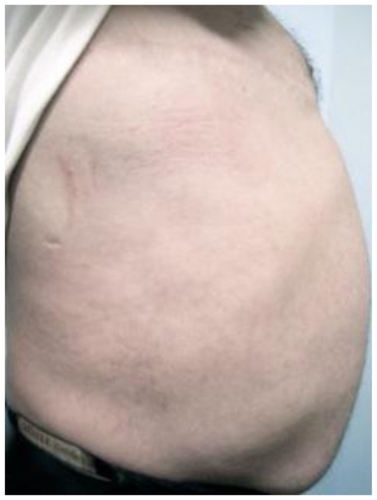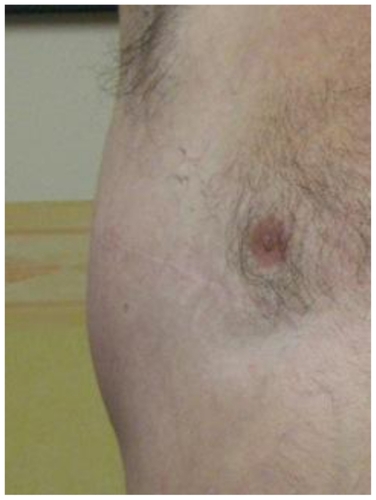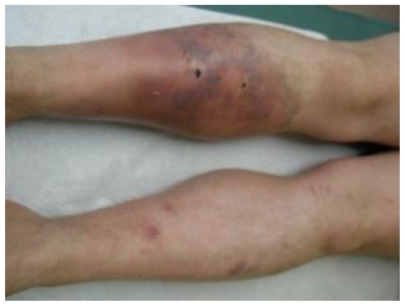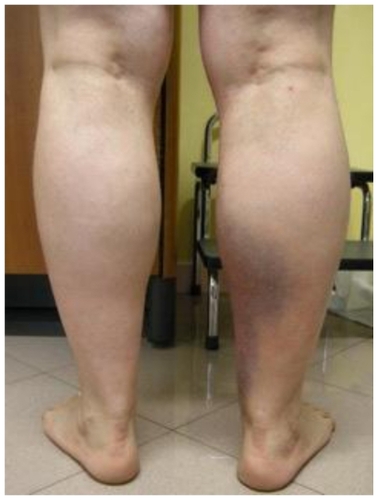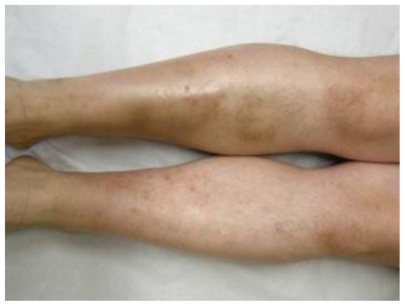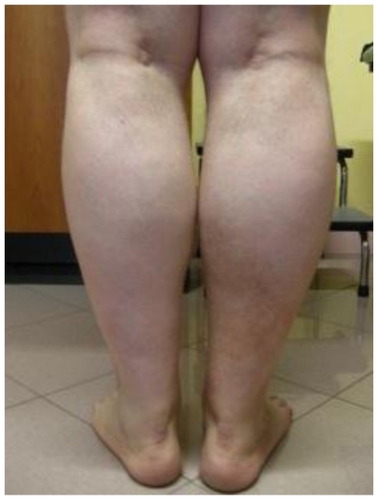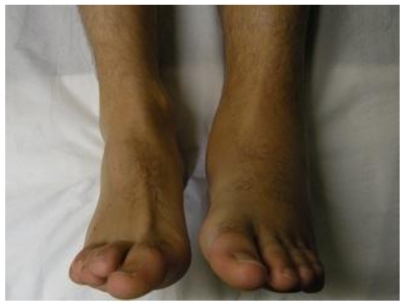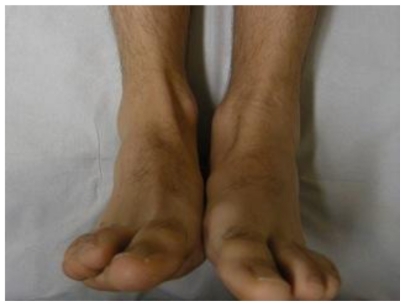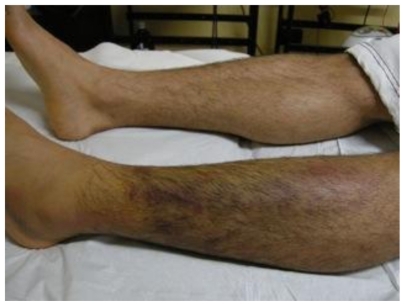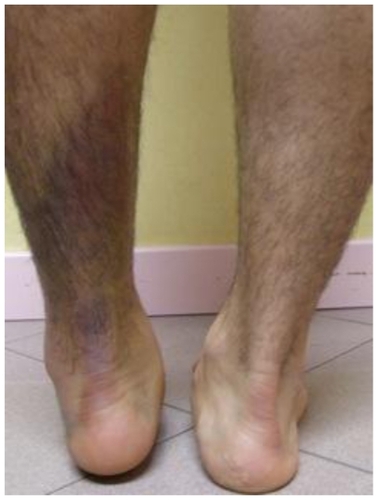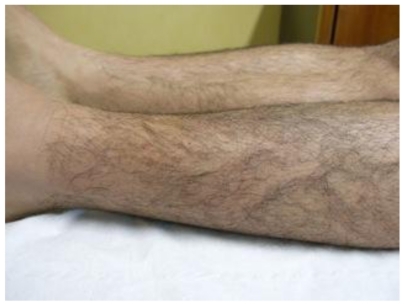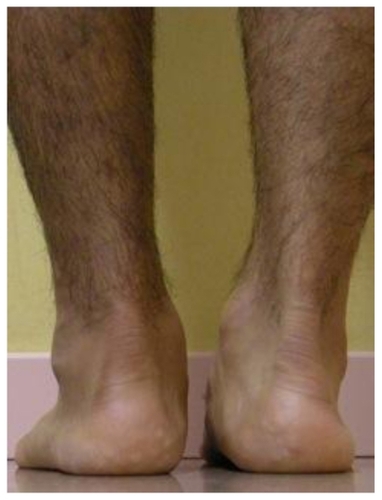Abstract
Background
For the past few years, treatment of contusions and associated symptoms, such as bruising, pain, and loss of function, has involved instrument-based therapies, ie, lasers, electromagnetic fields, and electrical stimulation. In this study, tissue optimization (TO) sessions were applied using a radioelectric asymmetric conveyor (REAC) for the treatment of contusions and associated symptoms.
Methods
Six subjects were treated with 12–18 sessions of REAC-TO applied to a traumatized anatomical area.
Results
In all cases, REAC-TO sessions were found to be effective for the treatment of post-traumatic injuries involving hematomas, hemorrhagic suffusion, and loss of function. In addition, REAC-TO treatments represented a rapid-acting analgesic associated with antiedematous, anti-inflammatory, and regenerative effects. These findings are consistent with the results of previous studies, and confirm the capacity of REAC-TO to provide almost immediate recovery of function in traumatized areas.
Conclusion
As previously demonstrated in vitro, REAC-TO is able to promote regeneration and repair processes in the human body. For six subjects experiencing local trauma, REAC-TO was effective in speeding the healing time of contusion symptoms and providing recovery of function.
Introduction
For the past few years, treatment for contusions and associated symptoms, such as hematomas, pain, and loss of function, have used instrument-based therapies.Citation1,Citation2 These have involved the use of lasers, electromagnetic fields, and electrical stimulation.
During the acute phase of injury, bruising and pain are typically treated with the application of ice, while the intermediate phase involves topical treatments, such as painkillers and heparinoids. When loss of function is involved, rest and functional rehabilitation are often initially prescribed. Upon completion of this period, treatment with physiotherapy equipment can be used to improve symptoms further, especially when residual pain and loss of function remain. In this study, application of a new technology for biostimulation is described for the treatment of post-traumatic injuries.
Materials and methods
Radioelectric asymmetric conveyor
A radioelectric asymmetric conveyor (REAC, Convogliatore di Radianza Modulante, Italy) represents an innovative biostimulation technology creating a radiofrequency field that can be applied to the body.Citation3,Citation4 Previously, this REAC technology has been applied to several areas of medicine, including brain stimulation,Citation5–Citation11 tissue stimulation,Citation12 and neuromuscular stimulation.Citation13–Citation16
Tissue optimization
The REAC tissue optimization (REAC-TO) protocol consists of the application of 100 radiofrequency 2.4 gHz bursts, 0.5 seconds in duration, associated with a specific absorption rate (of 7 μW/kg). The radiofrequency bursts are spaced 4.5 seconds apart, and are applied using a special laminar aluminum probe in proximity to the skin (). Each therapy session lasts about 10 minutes, and a REAC-TO treatment cycle generally consists of 12–18 therapy sessions. REAC-TO sessions have previously been shown to be effective in improving circulation, hydration, and tropism in the skin of the face in healthy subjects.Citation12 In as yet unpublished research, use of REAC was shown to modulate the expression of genes and proteins involved in the differentiation of stem cells and embryonic mouse cells, and to improve tissue regeneration.Citation17
Case 1
A 70-year-old woman was treated with oral anticoagulants after an accidental fall while descending a flight of stairs. The fall resulted in a significant hematoma, with hemorrhagic suffusion present in the buttocks () and inguinal canal (), resulting in significant pain in the traumatized areas. Immediately following the trauma, the subject started treatment with REAC-TO. Two sessions were performed per day, one hour apart, for six days. No other therapy was locally applied while REAC-TO treatments were being conducted. Following the first session, a rapid improvement were observed in the subject’s condition, and in her level of pain. As a result, an almost full recovery was achieved within six days ( and ).
Figure 2 Female 70 years old, treated with oral anticoagulants, accidental fall while descending the stairs. Before REAC-TO treatment.
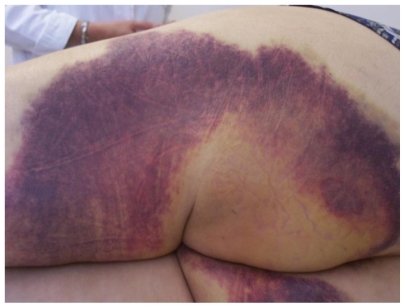
Figure 3 Female 70 years old, treated with oral anticoagulants, accidental fall while descending the stairs. Before REAC-TO treatment.
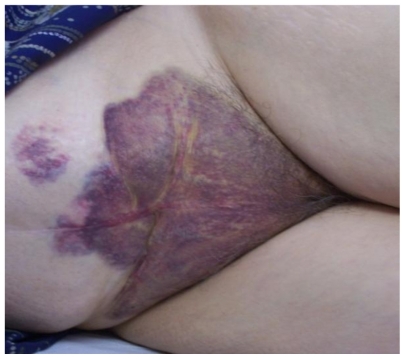
Case 2
A 60-year-old man sustained an accidental trauma involving a fall on the chest, which resulted in an underarm, subfascial hematoma (). The transverse diameter was approximately 13 cm, and a conspicuous ecchymotic suffusion extended to the iliac wing (). As a result of this trauma, the subject experienced severe pain when breathing and restricted arm movement ipsilateral to the lesion. Immediately following the trauma, the subject started treatment with REAC-TO. Two sessions were administered daily one hour apart on alternate days. A total of 18 sessions was conducted over three weeks. Following the first treatment, the pain experienced by the subject was sufficiently reduced to eliminate further treatment with painkillers. Furthermore, while the subject underwent REAC-TO treatments, no other therapy was administered locally. Following completion of treatment, the ecchymotic suffusion was completely resolved (), and the hematoma present in the underarm was almost completely resolved (). Moreover, the subject achieved full functional recovery of arm movement.
Case 3
A 30-year-old male experienced a crush injury to his right leg, with a conspicuous pretibial hematoma extending the length of the affected limb ( and ). Severe pain and functional loss of leg movement were reported. Treatment with REAC-TO was started two days after the injury, and included 18 consecutive daily sessions. After the first treatment, a significant decrease in pain and functional recovery was reported, eliminating the need for painkillers. While REAC-TO treatments were underway, no additional local therapy was applied. Following completion of the REAC-TO treatments, modest local edema and slight discoloration from hemosiderin deposition remained ( and ). However, total recovery of limb function was achieved.
Case 4
An 18-year-old man fell accidentally on a staircase, and experienced traumatic impact to the distal third of his right leg. As a result, the subject developed a conspicuous ecchymotic suffusion that extended to the tibiotarsal joint and heel ( and ). Severe pain and loss of function were reported. REAC-TO treatments were started immediately following the trauma, with two sessions conducted daily for 12 days. Following the first treatment, a significant reduction in pain and functional recovery were reported. During REAC-TO treatments, the subject also did not receive any other local therapies. After 12 days, complete functional recovery of the tibiotarsal joint was achieved, and the ecchymotic suffusion was resolved ( and ).
Figure 14 Male 18 years old, accidentally fell on the steps of a staircase. Before REAC-TO treatment.
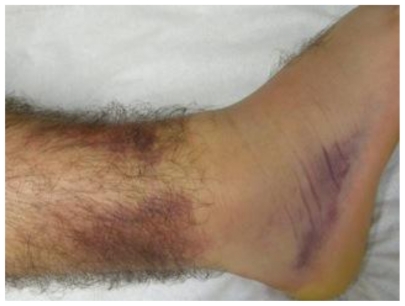
Figure 15 Male 18 years old, accidentally fell on the steps of a staircase. Before REAC-TO treatment.
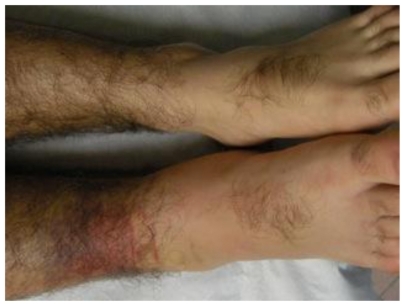
Case 5
A 35-year-old man accidentally fell from a ladder, resulting in a conspicuous ecchymotic suffusion that affected the tibiotarsal joint, and was associated with a hematoma in the heel (). Severe pain and loss of function in the traumatized limb were reported by the subject. REAC-TO treatments were started immediately, with two sessions conducted daily for a total of 18 sessions. Following completion of the first treatment, a significant reduction in pain was reported, and sufficient functional recovery was achieved to enable the patient to walk. The patient did not require further treatment with painkillers. Thirty days after the start of treatment, complete functional recovery of the tibiotarsal joint was demonstrated, and resolution of the hematoma in the heel was achieved. Recovery of salient bone features in the joint was also observed ().
Case 6
A 28-year-old man was hit by a car, resulting in a conspicuous ecchymotic suffusion that extended throughout the entire leg ( and ). Loss of function of the leg and significant pain were reported by the subject. REAC-TO sessions were started immediately, with two sessions conducted daily for 18 sessions. Following the first session, the subject reported immediate pain relief and demonstrated early functional recovery of the leg. The subject did not require further treatment with painkillers. During REAC-TO treatments, no additional local therapy was applied. Fourteen days after the start of treatment, functional recovery of the limb was observed and complete resolution of the suffusion was achieved ( and ).
Results
The images presented here for subjects here clearly demonstrate the effectiveness of REAC-TO, with recovery achieved following post-traumatic injuries involving resolution of hematomas and hemorrhagic suffusion. In addition, almost immediate and progressive recovery of loss of function was observed, with REAC-TO treatments representing a rapid-acting analgesic. REAC-TO treatments were also associated with antiedematous, anti-inflammatory, and regenerativeCitation17 effects.
Discussion
The cases and results presented in this study are representative of those achieved in our clinics with the application of REAC-TO to post-traumatic injuries. REAC-TO has shown efficacy in speeding the healing time of post-traumatic injuries compared with the time usually required for similar traumas treated with prompt functional recovery and rapid-acting analgesics. Furthermore, this treatment approach represents a noninvasive, painless, and safe treatment that provides functional recovery.
Conclusion
REAC-TO treatments are easy to administer, associated with rapid and effective action, especially in reducing pain and loss of function, and effective at any depth of damaged tissue. As such, REAC-TO represents a valuable tool in the treatment of various injuries, including emergency traumatic conditions.
Acknowledgments
The authors thank Dr Lucia Aravagli and Dr Stefania Bini of Rinaldi Fontani Institute, Department of Neuro Psycho Physio Pathology, Florence, Italy, for their helpful discussions.
Disclosure
SR and VF are the inventors of the radioelectric asymmetric conveyor.
References
- SheppardLAAnafSGordonJPatient satisfaction with physiotherapy in the emergency departmentInt Emerg Nurs20101819620220869660
- McClellanCMGreenwoodRBengerJREffect of an extended scope physiotherapy service on patient satisfaction and the outcome of soft tissue injuries in an adult emergency departmentEmerg Med J20062338438716627842
- RinaldiSFontaniVRadioelectric asymmetric conveyer for therapeutic useEuropean Patent Office: World Intellectual Property Organization10112006
- RinaldiSFontaniVRinaldiSFontaniVRadioelectric asymmetric conveyer for therapeutic useUS patent7,333,8592001
- CollodelGMorettiEFontaniVEffect of emotional stress on sperm qualityIndian J Med Res200812825426119052335
- MannuPRinaldiSFontaniVCastagnaAMargottiLMRadio electric treatment vs es-citalopram in the treatment of panic disorders associated with major depression: An open-label, naturalistic studyAcupunct Electrother Res20093413514920344882
- MannuPRinaldiSFontaniVCastagnaALong-term treatment of bipolar disorder with a radioelectric asymmetric conveyorNeuropsychiatr Dis Treat2011737337921822388
- MannuPRinaldiSFontaniVCastagnaARadio electric asymmetric brain stimulation in the treatment of behavioral and psychiatric symptoms in Alzheimer DiseaseClin Interv Aging2011In press
- RinaldiSFontaniVAravagliLMargottiMLPsychological and symptomatic stress-related disorders with radio-electric treatment: Psychometric valuationStress and Health20102615323005
- RinaldiSFontaniVAravagliLMannuPPsychometric evaluation of a radio electric auricular treatment for stress related disorders: a double-blinded, placebo-controlled controlled pilot studyHealth Qual Life Outcomes201083120302662
- RinaldiSFontaniVMorettiEA new approach on stress-related depression and anxiety: Neuro-psycho-physical-optimization with radio electric asymmetric conveyerIndian J Med Res201013218919420716819
- RinaldiSFontaniVCupelliVCapillaroscopy changes of the face, induced by activation with REAC tissue stimulation, in the treatment of local adaptation syndromeDermatologia Ambulatoriale2007XVII2935 (Italian)
- CastagnaARinaldiSFontaniVAravagliLMannuPMargottiMLDoes osteoarthritis of the knee also have a psychogenic component? Psycho-emotional treatment with a radio-electric device vs intra-articular injection of sodium hyaluronate: an open-label, naturalistic studyAcupunct Electrother Res20103511620578643
- CastagnaARinaldiSFontaniVMannuPRadioelectric asymmetric brain stimulation and lingual apex repositioning in patients with atypical deglutition: a naturalistic, open-label studyJ Multidiscip Healthc20114
- Australian New Zealand Clinical Trial RegistryEvaluation of the effectiveness of the neuro postural optimization therapy with conveyer of modulating radiance to treat functional dysmetria2007 Available from: http://www.anzctr.org.au/ACTRN12608000023358.aspxAccessed on August 02, 2011
- CastagnaARinaldiSFontaniVMannuPMargottiMLA comparison of two different treatments for coxarthrosis: local hyperthermia versus radio electric asymmetrical brain stimulation. A retrospective case seriesClin Interv Aging2011In press
- MaioliMRinaldiSSantanielloSRadio elctric asymmetric conveyed fields are able to modulate the expression of genes and proteins involved in the differentiation of embryonic mouse cells and stem cellsPaper presented at the Consorzio Interuniversitario Istituto Nazionale di Biostrutture e Biosistemi, IX Convegno Nazionale2010, October 21–22Roma, Italy
